
Meet the Author with the Best Job in the World – Ben Mims
The food researcher, recipe tester, and author of Crumbs: Cookies and Sweets from Around the World, tells us all we need to know and more about cookies.
A friend of Ben Mims recently told him how he thought of cookies as ‘condensed excess’. The former Saveur and LA Times food writer, who’s just published his new book with Phaidon, Crumbs: Cookies and Sweets from Around the World, laughs at the description.
“Everyone has that universal want to have something sweet that makes them feel luxurious, feel richer, feel super happy for a time,” he tells Phaidon.com. “Cookies are like edible forms of drugs that everyone has access to. That’s their core appeal through the centuries.”
In Crumbs: Cookies and Sweets from Around the World, Ben follows the journey of the not so humble cookie across the globe. Along the way he traces the traditions and the histories and how to recreate each country’s cookie in your own kitchen.
Travelling through time, and across countries and cultures, it’s a unique investigation into what the cookie means to each and every one of us; from the spices used in Egyptian cookies, through the swirls on top of those from Nepal, to the inspired inclusion of raisins in cookies in Iran.
There’s nothing cookie cutter about the definitive cookie culture on offer in Crumbs: Cookies and Sweets from Around the World. We asked Ben a few questions about it.
 Persian Raisin Cookies. Iran. Photography: Simon Bajada
Persian Raisin Cookies. Iran. Photography: Simon Bajada
You went from culinary school straight into the kitchens of Jean-Georges Vongerichten, which is pretty good going. How did that happen? I was in culinary school in New York City, and I needed a job. They wanted me to get halfway through the programme before I looked for work, but I was poor, I was there alone, and I needed work!
I got a job with his recipe testing chef. His job was to come up with new dishes for Jean-Georges. I worked with him for a few months and was then sent down to Perry St which was a Jean-Georges restaurant run by his son. I cooked a lot there. That was interesting because it first alerted me to the idea of recipe testing and what that means. When I left I applied for a job at Saveur magazine, researching background for articles, and getting to write a lot of my own too.
The round up style articles I was doing helped me find out about all the different resources to use to find every single version of an ingredient that exists. That influenced my want to develop recipes, write cookbooks, and just be curious. Why is that there? And where did this come from? Rather than just, ‘oh this mac and cheese has chillies in it, cool’.
 Fried Whole Wheat Biscuits. India, Nepal. Photography: Simon Bajada
Fried Whole Wheat Biscuits. India, Nepal. Photography: Simon Bajada
The number of books and websites listed under the research for the book is the most exhaustive we’ve ever come across. It was a lot. I wanted to make sure that at least every cookie in the book had at least three sources, which was difficult for some of them. Everything is based in fact and history and with so many sources that no one can say I was editorialising or picking favourites. The approach was literally: this is what’s out there; this is all the information and history on it. I’m not putting my opinion on things, that’s partly why there was such an extensive biography.
It works to the book’s favour. I don’t have a history degree from university to back me up, but as a journalist for 15 years now, I have my curious nature about wanting to understand the ‘why’, and the ‘where’, and the ‘when’ to everything. Fifteen years ago when I first started working at Saveur, the magazine took an anthropological approach to all food. I remember we wanted to do a Christmas cookies list one year, not just some fun new flavours but cookies that have an actual history and tradition of being produced around Xmas and holidays and why.
That sparked my own interest in how something as simple as a lump of sugar, and flour, and butter can have history and meaning behind it. That’s how I have been looking at all the food I’ve been interested in since. When it came time to write this book. I wanted to recreate that. I obviously go into more of the history of cookies and discovering what has been happening naturally around the world in the past thousand years since cookies have been a thing.
 Nut-Filled Shortbread Cookies. Lebanon, Palestine, Syria. Photography: Simon Bajada
Nut-Filled Shortbread Cookies. Lebanon, Palestine, Syria. Photography: Simon Bajada
Was there a formative experience for you and cookies when you were a kid in Mississippi? Cookies were the first thing I learned to make as a kid. My mother, my aunt, my grandmother, all the women in my family, were big bakers. Being from the South a lot of the food is very rich, it’s very sugary it’s very over the top; and that’s not celebration food, that’s everyday food. We would have a big piece of cake, or pie, or some rich desert every day. If it wasn’t something like that we always had cookies. Every single meal you ate you had to have something sweet.
And then as I grew older my need for sugar lessened. I moved to New York. I learned about what healthy eating is and I changed, but cookies were always a treat. If I was stressed, and wasn’t smoking, I was eating a cookie. It was the thing that we go to for comfort and that also informed the book. Cookies are this indefinable foodstuff. They’re for holidays and they’re for special treats, but they are also for every day.
 Guava and Almond Thumbprint Cookies. Dominican Republic, Puerto Rico. Photography: Simon Bajada
Guava and Almond Thumbprint Cookies. Dominican Republic, Puerto Rico. Photography: Simon Bajada
What were the cookies that really surprised you once you began your research? A lot of the surprise was seeing cookies that I did know about obviously, mostly in western Europe and some in south America, seeing the origins of them and then also seeing how the form has taken on certain characteristics in other places.
Take for instance the Vanilla Kipferl. In Austria it’s the iconic crescent cookie with walnuts covered in powdered sugar, but you see it all over the world. It’s called a wedding cookie in some places. It was really interesting tracing that from Iran and Turkey, seeing how the crescent shape was already there. It was this buttery cookie that was maybe covered in walnut first but then the walnut got into the cookies themselves which were covered in regular sugar and then that became powdered sugar in Austria.
Then that cookie showed up in Indonesia as the same shape but now the walnuts are like a sugary filling that’s stuffed inside the dough and decorated ornately with cones. There were so many ways I was surprised by how just the combination of flour, sugar, and butter could yield such different things.
 Piped Cardamom Butter Cookies. Somalia. Photography: Simon Bajada
Piped Cardamom Butter Cookies. Somalia. Photography: Simon Bajada
Did you find that certain countries have a character type when it comes to cookies or a character that emerges when the cookie reaches their shores? Definitely. I would say that informed how the chapters were laid out. Yes, it’s by region, but when I was looking at them, trying to figure how to put them together, there were definitely region specific themes when it came to ingredients and the way they were combined.
The Balkans, Greece, Bosnia and Macedonia - that whole area - loves to soak a cookie in a syrup afterwards and then cover it with nuts.
In Scandinavia they have different shapes that only appear in Scandinavia. They have cookies where you take a whole roll of cookie dough and bake the whole thing, and then slice it afterwards, instead of before. They cut their cookies in these diamonds typical of that area.
Different shapes would appear from different regions. Different styles of folk art appear a lot in the Mediterranean cookies in Spain and Italy but not in north Africa, but that’s where you get all the dates and the orange blossom water and rose water.
 Pine Nut-Covered Macaroon Cookies. Spain. Photography: Simon Bajada
Pine Nut-Covered Macaroon Cookies. Spain. Photography: Simon Bajada
And then, of course, America has completely different cookies. Ours are super chewy, super sugary, grainy and meant to be a rich desert, whereas cookies in the rest of the world are dense, crumbly, brittle, smaller and meant to be eaten with coffee or tea.
With south American cookies, pretty much all of them were influenced by Spain and Portugal but they adapted to use tapioca starch or casava flour or used guava and lime instead of poppy seeds and walnuts and apples.
It was cool to see all of those together and to have a ‘now this makes sense moment’. It helped to be able to put them in these different regions based on the similar way that they approached making their cookies.
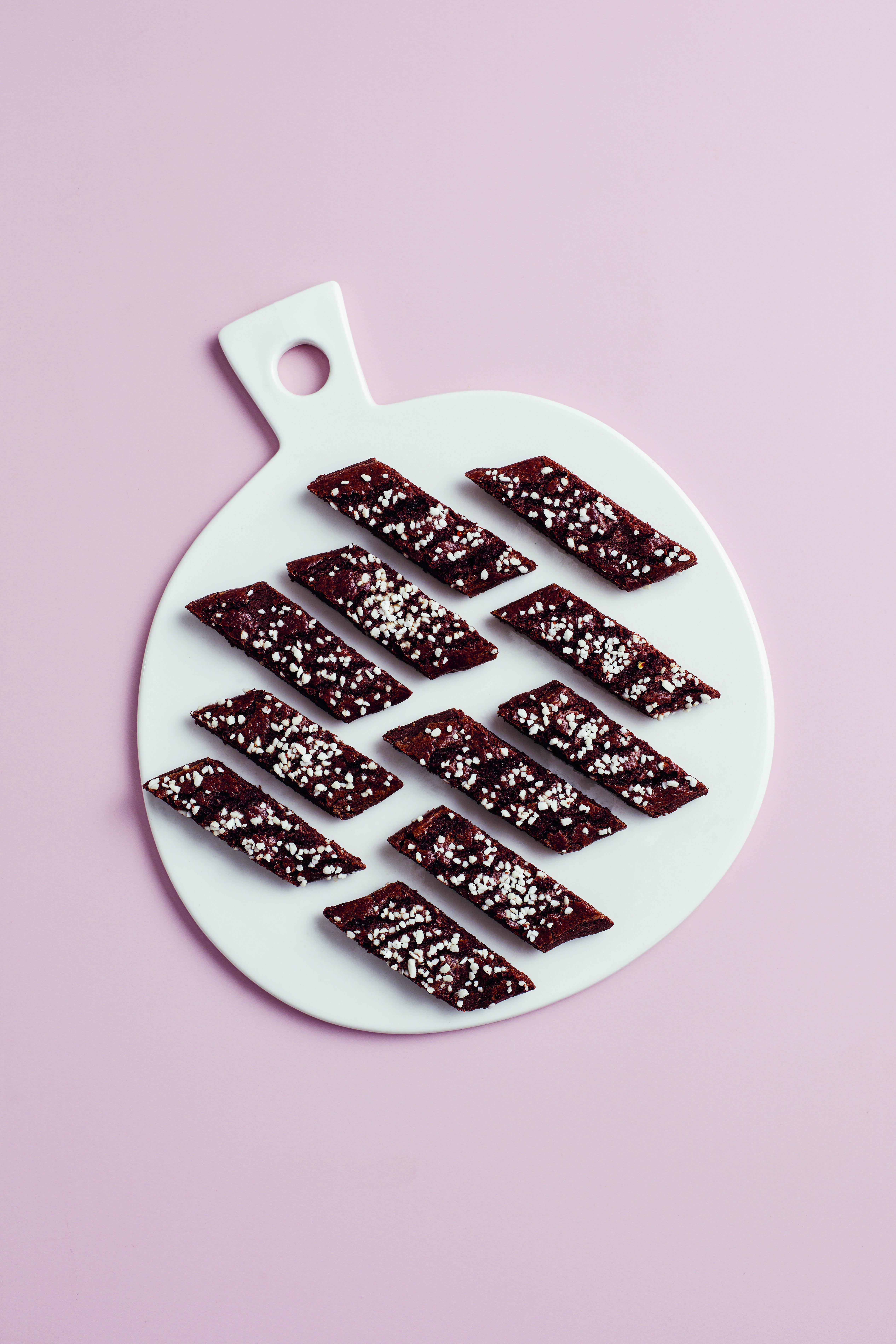 Chocolate Slice Cookies. Sweden. Photography: Simon Bajada
Chocolate Slice Cookies. Sweden. Photography: Simon Bajada
What actually makes a great cookie? I think it’s all about texture. That helped me define what a cookie was for the book. It can be brittle, it can be dense, it can be chewy, but it has to have some physical ‘give’ that you need to go after with your teeth. If it is baked like a stereotypical two-inch hockey puck then it can be called a cookie, but that can still get into cake territory, or even a fritter if it’s fried. The dryness I think is good because you want to eat it with coffee or tea and that re-moistens it.
The American ones that are not like that, but those have a sugary chewiness to them that’s very satisfying as well. The flavour can be as simple as good butter and some salt and sugar, or it can have chocolate, and spices, and icing, but definitely a chewy texture makes the best cookie and makes it super satisfying.
 Filled Cream Cookies. Poland. Photography: Simon Bajada
Filled Cream Cookies. Poland. Photography: Simon Bajada
On the subject of edible drugs, what is your personal crack cocaine cookie? Ooh, that’s a good one. I think it might be a Ginger-Molasses cookie. Which was also fascinating to track the history of. Gingerbread-Molasses cookies came to the UK and it’s clear that they morphed with golden syrup. But molasses is not like golden syrup or honey, it has a very different, more bitter flavour.
When it got to America it morphed with the American sugar cookie, so now the Ginger-Molasses cookie that most people think about in America is similar to a sugar cookie; it’s a little bit thicker but there’s powdered ginger, there’s candied ginger, there are big sugar crystals around the outside. It’s a little bitter, it’s really spicy, with the crunch of the sugar outside. I could eat those every day. I actually have eaten a lot of those through my life.
 Soft Spiced Gingerbread Cookies. Czech Republic. Photography: Simon Bajada
Soft Spiced Gingerbread Cookies. Czech Republic. Photography: Simon Bajada
The history is endlessly fascinating, but did you discern a future direction in which cookies are heading? I do see a lot of more American style sugary cookies making their way around the world. Also in the U.S. there’s a big argument around new cookie bakeries that make cookies that are super thick and almost raw inside.
People love raw cookie dough for some reason - that over the top cakey thing - which I find really gross. Unfortunately, it’s really popular and I see a lot more of it in New York and LA. Basically you’re eating a whole pie in sugar cookie form. I find that really gross. But people want excess.
Reading the book it seems most of that historical innovation came from home cooks. What inspires cookie makers? Is it a slightly scientific thing or a more homespun thing I think it’s more homespun. I think it’s a desire to create, at least in America. I traced the popularity of making cookies at home back to pamphlets and magazines geared towards women and mothers in the forties and fifties.
They were full of articles like this is how you make a home, how you keep a family, how you create this idyllic American dream life. It was all about making cookies and having this Norman Rockwell view of family and keeping these sweet things around to make that dream come true.
 Welsh Griddled Currant Cookies. Wales. Photography: Simon Bajada
Welsh Griddled Currant Cookies. Wales. Photography: Simon Bajada
Is it actually humanly possible to not like a cookie? Is there one cookie you can’t stand? I hate to say no, but, I mean I would say some of the more challenging ones were the ones made with corn starch or tapioca. You bite into them, and they dissolve in a weird way that I think we’re not used to because we’re so used to regular wheat flour. But they’re still good on their own.
There’s an Icelandic cookie I include in the book. It’s the only one that’s based with the meringue that’s chocolate and liquorice mixed with a brown sugar meringue, and I usually hate liquorice and I bit into this, and I was like, ‘Oh, with the extra sweetness of the chocolate I don’t hate it.’ It was my least favourite, but I didn’t hate it.
 Dulce de Leche-Filled Butter Cookies. Argentina. Photography: Simon Bajada
Dulce de Leche-Filled Butter Cookies. Argentina. Photography: Simon Bajada
OK. Let’s end on three things a home cook can do to make their cookies better. Buy good ingredients. The better the butter, the nicer the honey, the fresher the spices the greater the cookie. The more potent the extracts or using real ones versus imitations makes a huge difference in the way that the flavour sits in the cookie.
Patience. I found a lot of cookies during the book that are made to improve with time. We tend to eat them as soon as they’re cool. But some you want to put in a container and let them sit for a day or two. Yeah they’re going to dry out a little but that will create the texture that they’re supposed to have.
Try to eat different cookies than you would normally like. I hate liquorice but I had to eat it for the book. There are some combinations of flavours that work well together even if you might not like the individual flavour.
 Buy Crumbs: Cookies and Sweets from Around the World, in the store.
Buy Crumbs: Cookies and Sweets from Around the World, in the store.